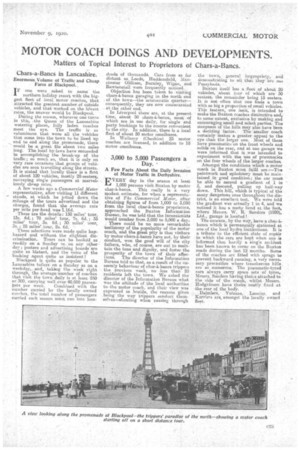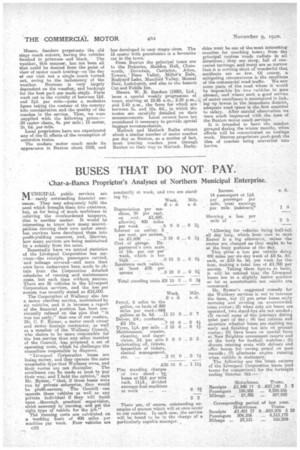MOTOR COACH DOINGS AND , DEVELOPMENTS.
Page 53

Page 54

If you've noticed an error in this article please click here to report it so we can fix it.
Matters of Topical Interest to Proprietors of Chars-a-Bancs.
Chars-a-Bancs in Lancashire.
Enormous. Volume of Traffic and Cheap Fares at Blackpool.
IF one were .asked to name the northern holiday resort with the biggest fleet of local motor coaches, that attracted the greatest number of outside vehicles, and that worked on the ldwest rates, the answer would be Blackpool.
During the season, wherever one turns in this, the Queen of the Lancashire watering places, fully laden coaches meet the eve. The traffic is so voluminous that were all the vehicles that come into the town to be lined up end to end along the promenade, there would be a great file about two miles long. The local by-laws have succeeded In accomplishing the break-up of the traffic; so much so, that it is only on very rare occasions that groups of vehicles are seen travelling along the streets. It is stated thatlocally there is a fleet of about 120 vehicles, mostly 28-seaters conveying singe passengers at marvellously cheap rates.
A few weeks ago a Commercial Motor representative, after visiting 11 different stands, at which he jotted dawn the mileage of the tours advertised mud the charges, found that the average rate per mile per-head was 1.16d. These are the details: 150 miles' tour, 13s. 6d. ; 78 miles' tour' 7s. 6d. ; 35 d.
miles' tom-, 3s. 6 ; 30 mile? tour, 3s. ; 25 miles'tour, 2s. 6d.
These selections were made quite haphazard and without the slightest discrimination. Tours can be hooked as readily on a Sunday as, on any other day ; posters and advertising boards are quite as blatant, and the voice of the -booking agent quite us insistent
Blackpool is quite as popular, to the Lancashire toilers. on a Sunday as on a weekday, and, taking the week right through the average-number of coaches that visit the town daily is at least 250 or 300, carrying well Over 40.000 passen
gers per week. Combined with the number carried by the locally owned coaches, the total number of passengers carried each season must run into hon
dreds of thousanda. Cars from as far distant as Leeds, Huddersfield, Manchester Oldham, Burnley, Wigan., and Rawtenstall were frequently noticed. Objection has been taken to visiting chars-h-basics garaging in the north end of the town—the aristocratic quarter-consequently, they are now concentrated at-the other end.
In Liverpool there are, at the present time, about 50 chars-it-banus, most, 0.1 which are in use daily, for single and party bookings to the resorts convenient to the city. In addition, there is a local fleet of about 50 motor omnibuses,
In Wallasey (Cheshire) 25 motor coaches are licensed, in addition to 18 motoromnibuses.
3,000 to 5,000 Passengers a Day.
A Few Facts About the Daily Invasion of Motor Traffic in Derbyshire.
EVERY day in the season at least 1,000 persons visit Buxton by motor char-i-banns. This really is a very modest estimate,. for when a representative of The Commercial Motor, after obtaining figures of from 1,000 to 3,C00 from. the local char-a-banes proprietors, approached the Buxton Information Bureau, he was told that the incursionists Would number from 3.000 to 5,000 aday, There could be no more remarkable testimony of the popularity of the motor coach, and the great pity is that visitors by motor chars-a-bencs have not, by their conduct, won the good will of the city fathers, who, of course, are out to maintain the tone and dignity, and foster the prosperity of the town of their affections. The director of the Information Bureau told us that, ass-a result of the unseemly behaviour of char-a-bancs trippers the previous week, no less than 20 residents left the town. We asked the director of the Inforreation Bureau what was the attitude of the local authorities to the motor coach, and their view was expressed as hostile, the reasons given being the way trippers conduct themselves—shouting when passing through the town, general impropriety, and demonstrating to all that they. are nur Pussyfoots.
Buxton itself has a fleet of about 20 vehicles, about four of which are 30 seaters, the remainder being 15 seaters. It is notoften that one finds a town with so big a proportion of small vehicles. This feature, one feels, is intended to make the Buxton coaches distinctive and, to some extent, exclusive by making and encouraging small and select parties. The steepness of the hills may also have been a deciding factor. The smaller coach certainly makes a greater appeal to the eye than the larger one. Most of them have pneumatics on the front wheels and solids on the rear, and at one garage we were informed that it was intended to experiment with the use of pneumatics on the four wheels of the larger coaches. Amongst the conditions which a motor -coach in Buxton must fulfil are :—The paintwork and upholstery must be maintained in good condition.; the ear must be able to ascend a gradient of 3, in 5, and descend, pulling up half-way down. This hill, which is typical of the many dangerous ones throughout the district, is an expellent test, We were told the gradient was actually 1 in 4, and we noticed it has a nasty bend at the foot, where Messrs. W. R. Sanders (1920), Ltd. garage is located The concern, by the way, have a char-hbanes which is permanently stationed at one of the local hydro institutions. It is a tribute to the efficient state of repair in which the cars are kept when one is informed that hardly a singe accident has been known to occur on the Buxton roads during the lest 12 months. Some of the coaches are fitted with sprags to prevent backward running, a very necessary precaution where treacherous hills are so numerous. The prieumatic-tyred cars always carry spare sets of tyres, Messrs. Sanders having theils attached to the side of the coach, whilst Messrs. Hodgkinson have theirs neatly fixed at -the rear of the body.
Daimlers, Vulcans, Laucias, and Karriers are amongst the locally owned fleet. Mews. Sanders perpetuate the old stage coach colours, having the vehicles finished in primrose and black. The weather, this summer, has not been all that could be desired from the point of view of motor coach touring—on the day of our visit not a single coach turned out, owing to the inclemency of the weather. Business is very largely dependent on the weather, and bookings for the best part are made singly. Fares work out in the vicinity of between 1id. and 21d. per mile—quite a moderate figure taking the contour of the country into consideration and the quality of the coaches in the service. Thus, we were supplied with the ZoHawing prices :30 seater ehera, 4s. per mile; 15 seater, 2s. 6d. per-mile. Local proprietors have-not experienced any of the ill effects of the resumption of excursion trains.
The modern motor coach made its appearance in Buxton about 1910, and has developed in easy stages since. The 15 seater with pneumatics is a favourite ear in the town. From Buxton the principal tours are to the Dukeries, Hadffon Hall, Chatsworth, Dovedale, Castleton, Alton, Towers, Dane Valley, Miller's Dale, Rudyard Lake, Manifold Valley, Monsal Dale, Ludchuirch, and also to the famous Cat and Fiddle Inn.
Messrs. W. R. Sanders (1920), Ltd., issue a special weekly programme of tours, starting at 10.46 a.m., 2.30 p.m,:s
and 2.45 p.m., the fares for which are between 5e. and 10S. 6d_, in which the routes are carefully detailed on their announcements. Local owners have hot considered it necessary to provide special luggage accommodation. Matlock and Matlock Baths attract about a similar number of motor coaches per day as Buxton, as a matter of fact, most Willing coaches pass through Buxton on their way to Matlock. Derby' shire must be one of the most interesting counties for coaching tours; from the principal centres roads radiate in all directions; they are steep, full of concealed turnings, and many are so narrow that it is nothing short of wonderful that accidents are so few. Of course, a mitigating circumstance is the smallness of the commercial road traffic. We saw some parts of the road where it would be impossible for two vehicles to pass abreast, and where such a. good service of motor omnibuses is maintained in linking up towns in the immediate district, adequate road space is the first essential to safety. After careful observation we were much impres,ed with the tone of the Buxton motor coach services. It is intended to have the coaches garaged during the winter months, when efforts will be concentrated on haulage work. Buxton proprietors pooh-pooh the idea of coaches being converted into lorries.


























































